Chapter 6
Structural change in the market for small business finance
Introduction
6.1
The Australian banking market is dominated by four large banks, now
accounting for around ¾
of the market. This has resulted from a series of mergers going back more than
a century (Charts 6.2 to 6.6).
6.2
The Committee has commented in an earlier report:
A consequence of these mergers has been a long-run tendency
towards increased concentration within the Australian banking industry. There
was a temporary reduction in concentration with the deregulation of the 1980s,
mostly reflecting the entry of foreign banks and conversion of the larger
building societies, but this has now been overwhelmed by the ongoing mergers.
As a result the Australian banking market is now, by some criteria, the most
concentrated it has been for more than a century...The Australian banking market
is now quite concentrated by international standards. This is likely to be one
reason it is more profitable, and has wider interest margins, than banks in
most comparable countries...[1]
6.3
Since the start of the global financial crisis, Westpac has taken over
St George and the Commonwealth Bank has taken over BankWest, further
entrenching the dominance of the four majors (Chart 6.1)
Chart 6.1: Lenders'
shares of business credit
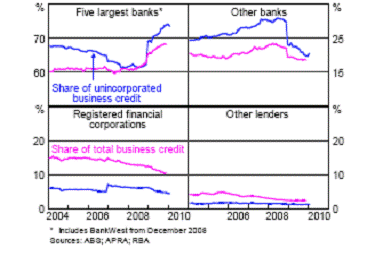
Source: Reserve Bank of Australia, Submission 2, p. 6.
Chart 6.2: Commonwealth
Bank family tree
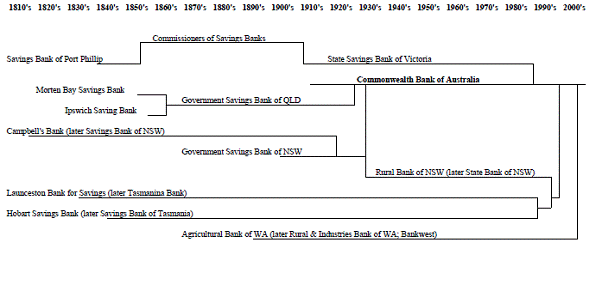
Chart 6.3: ANZ
Bank family tree
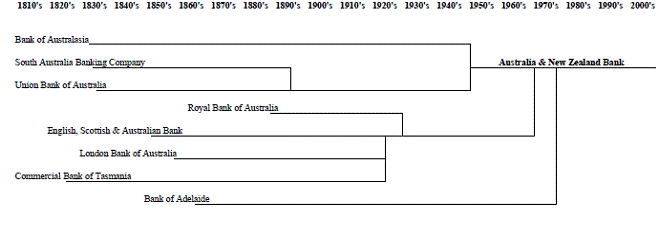
Chart 6.4: National
Australia Bank family tree
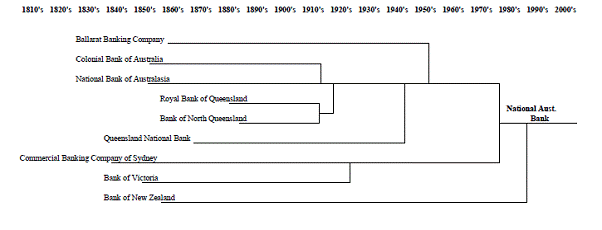
Chart 6.5: Westpac
Bank family tree
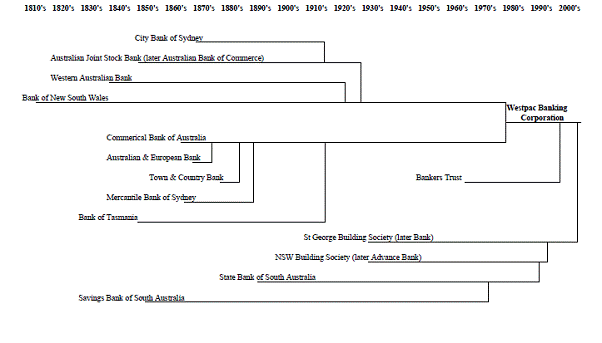
Implications for small business lending
6.4
As banks become larger they are more able to make large loans to large
companies. It has been suggested that this may lead to them being less interested
in lending to small business.[2]
Overseas studies have found some empirical evidence that larger banks make a
smaller proportion of their loans to small business.[3]
6.5
A tendency for mergers between banks may also go some way to explaining
the observation that internationally:
...there is anecdotal and increasingly statistical evidence
that Small and Medium Enterprises have not benefited from this financial
deepening to the same extent as other borrower groups...[4]
6.6
A cross-country study by World Bank economists concluded that more
concentrated banking systems particularly disadvantage smaller businesses:
Our results indicate that in more concentrated banking
markets firms of all sizes face higher financing obstacles and are less likely
to receive bank financing. This effect decreases as we move from small to
medium and large firms...[5]
6.7
Treasury offered some support to the proposition that larger banks lend
more to larger companies (to the extent that 'local' refers to regional banks
such as St George and BankWest that have been taken over by national banks):
Senator EGGLESTON—Do you suppose that the local banks might
have a better perception of local economic circumstances and be more prepared
to consider propositions because they better understand the local economy?
Mr Murphy—Yes.[6]
6.8
The Australian banks have implicitly agreed, as they have indicated that
they are being constrained in their involvement in making loans to large
business by their size. While they do not put it in these terms, this suggests
that as they become larger they will focus a larger proportion of their
attention on very large loans and by implication a smaller proportion of their
assets will be in loans for small business. For example, then Westpac CEO David
Morgan commented:
To out it bluntly, the Australian majors need scale...Westpac
often finds itself competing against organisations ten times our size. So no
one should be too surprised when we do not feature in the 'mega deals'. Size
does matter when it comes to lead bank roles and taking on the exposures
involved.[7]
6.9
The Reserve Bank also implicitly support this view as they comment:
The major banks are a particularly important source of debt
funding for small businesses...Foreign-owned banks provide only a small share, in
part because they do not have a substantial branch network.[8]
6.10
Small business loans make up 12 per cent of St George's loan book but
only 5 per cent of the larger bank Westpac's loan portfolio.[9]
6.11
Asked for their view, the Australian Prudential Regulation Authority
replied:
Some historical context may be of use here. In some countries
such as the United States and Japan, the current larger banks originated as ‘city’ banks with a focus on large business lending, while smaller banks
started in regional centres and naturally had more focus upon personal and
smaller business lending. This is not the historical pattern in Australia. In
Australia, the current smaller banks and other ADIs typically originated as
home lenders and personal lenders, and the larger commercial banks dominated not
only large corporate loans, but small and medium enterprise loans. Based on
statistics available to APRA as at end-December 2009, there is no clear pattern
that supports the view that large banks concentrate on lending to large
business while smaller banks focus on small business. There is considerable
variation from bank to bank depending on their business strategy, with some
larger banks having a relatively higher share of lending to small business.
Regional banks as a group tend to have a relatively high share of small
business loans to total loans.[10]
6.12
APRA also did not believe their 'large exposure' limits would have the
effect of precluding smaller banks lending to large companies:
APRA has large exposures limits for different classes of
counterparty as a percentage of the ADI’s capital base. The maximum for
non-Government non-ADI counterparties is 25 per cent of capital; typically,
there are limited exposures beyond 10 per cent of capital to this category of
borrower. It is unlikely that APRA’s requirements would limit the ability of
ADIs to lend to large businesses and thus have the suggested impact on lending
to small business. ADIs also have their own limits on exposures to individual
borrowers and sectors as part of their internal risk management and these
limits are aimed at avoiding a concentration of exposures to individual
counterparties, groups, sectors or geographical regions.[11]
6.13
As well as having less enthusiasm for small business lending, there is
some evidence that the major banks (the upper line in Chart 6.2) tend to have
wider interest margins than do the regional banks.
Chart 6.2: Australian
Banks' Net Interest Income

Source: Reserve Bank of Australia, Financial Stability Review,
March 2010, p. 18.
6.14
Some business groups have also expressed concern that mergers are
leading to an overly concentrated banking industry:
...our marketplace must stay open to new entrants. Secondly, we
must show more scepticism about claims that the merger of second and third tier
financial institutions will not lessen competition. It does, it has and it
will.[12]
Consultations with small businesses suggest that over and
above the lack of credit due to the recent tightening related to the GFC, there
is potentially a lack of competition in the market for lending to small
businesses.[13]
When you see...a functioning oligarchy...then obviously it is
going to be an issue in terms of the provision of competition...[14]
The ARA notes widespread concern regarding the lack of
competition in the banking sector leading to higher fees and interest rates,
standard non-competitive products and a general ignorance and disinterest
about the lending requirements of small business.[15]
6.15
Large banks may centralise credit assessment, with adverse consequences:
...loan applications from Far North Queensland may be assessed
in Sydney, where there is no “local” knowledge of regional industries. This has
impacted on the ability of rural and other localised industries to obtain
funding.[16]
6.16
There is evidence that the ever larger banks are losing credit
assessment abilities relevant to small business lending:
In a recent poll conducted by ACCI during March 2010, 34 per
cent of the 215 business respondents reported that their business bankers do
not have adequate understanding of their business’ cash flows and its ability
to service any current or prospective loan obligations.[17]
We have observed over the last decade and a half that there
has been a stripping out of trained business lending officers within the
banking system in favour of lending for households...It has basically meant the
demise of the local bank manager, and that has had an impact on the capacity of
banks to assess risk.[18]
6.17
Westpac refers to actions it has taken which might offset this tendency,
commenting:
Westpac commenced a significant investment in grassroots
banking in 2009, including bringing back the local Bank Manager and empowering
branches to better support local communities. The 18 month program is well
progressed - Westpac has created over 1,300 roles which include 530 new Bank Managers
and 59 regional managers and will have recruited over 700 new branch staff by
mid-year to support our renewed focus on customerfacing representation.
Business customer representation has also been increased, with 150 new
commercial bankers recruited in 2009 and another 50 are expected to have been
recruited by the middle of this year. St George has similarly significantly
increased the numbers of its SME relationship managers in the past two years.[19]
6.18
National Australia Bank has referred to the virtues of:
...doing business with customers you can see from the local
church spire.[20]
6.19
There has been a reduction in competition within specific segments of
the finance market. For example, in the equipment leasing space:
Lenders whose products are no longer available to Equipment
Finance Brokers include ABN Amro Ltd, Adelaide Bank, AGC Ltd (independently of
Westpac), Bendigo Bank, Colonial State Bank, G E Commercial Finance, Members
Equity Bank, Orix Australia Corp, Societe Generale (SG) Aust Ltd and Suncorp
Metway Ltd. Each departure from this market removes a particular expertise or
product range, leaving fewer options available to Small Business borrowers.[21]
6.20
A specific merger was raised by the Western Australian Farmers'
Federation. They oppose the proposed acquisition by ANZ Bank of the deposit and
loan books of Landmark Financial Services. Their concern is that:
Traditionally, lending facilities provided by Landmark
incorporate assessment of the value of a farm business in the decision making
process. Effectively, if a farmer sells their produce through Landmark, the
lender controls the farm cash flow. Purchase of merchandise, insurance and
agronomic services through Landmark also provide an income stream to Landmark.
These facets of this lender/borrower relationship in some instances will result
in lending criteria being more flexible than is the case in a traditional
lender/borrower relationship with a banking institution. Interest rates are
generally of a higher level to compensate for increased risk in these instances
but a lender such as Landmark will in all likelihood extend finance in times of
seasonal downturn beyond which a banking institution will ...WAFarmers does not
believe that this latitude would be continued under normal banking criteria
imposed by the ANZ ...The very real threat of the proposed acquisition should it
proceed will be that the ANZ will cherry pick the loan book of “secure”
borrowers, discard those that don’t meet their criteria and retain the deposit
book.[22]
Regulated lending
6.21
A possible response is to have regulations mandating minimum proportions
of lending to small business:
I am aware of some South East Asian countries—I think the
Philippines—where banks have to put 25 per cent of their loan book into small
business.[23]
...we really need to put in place some sort of structure to
ensure that a certain proportion of bank lending continues to go to the
small-business sector.[24]
6.22
Professor Sathye doubted this is feasible in Australia:
The second way could be—of course, it’s probably not
plausible in Australia in a market economy—to give some sort of mandated
target. But that would be interfering in the free market.[25]
Increasing competition from
non-bank lenders
6.23
Building societies and credit unions, particularly in regional areas,
may be able to provide more competition for the small businesses. They
identified as an impediment to their competing that it costs them more to raise
funds as many potential customers are under the misapprehension that the mutual
organisations do not meet the same prudential standards as the banks:
But every bit of market research testing we do, and all our
dealings with commentators, show us that in particular credit union and
building society brands are perceived as less well regulated than the major
banks. There is very, very limited understanding of the fact that we have got a
harmonised prudential system in Australia. There is very little understanding
that on all the risk measures you look at—and it is not just here in Australia
but under the Basel Framework globally—the credit union systems have come out
as particularly resilient because they are particularly conservative and do not
have access to the same kind of risks that internationally operating and
complex businesses do, and all the complexity around their balance sheets.[26]
6.24
Abacus suggests allowing building societies and credit unions to style
themselves 'mutual banks' may overcome this disadvantage.
Committee view
6.25
In its 2009 report on bank mergers, the Committee supported retention of
the 'four pillars' policy. It also recommended that:
...the Government request the ACCC, APRA and the Reserve Bank
to provide a joint annual report to parliament on competition in the retail
banking market in Australia, and the provision of affordable banking facilities
to those on low incomes, but taking care not to increase unduly the reporting
burden on financial institutions.[27]
6.26
The Committee still holds to these views and also sees value in the
annual report addressing the provision of finance for small business.
6.27
The Committee is concerned that takeovers of regional banks by major
banks are not only reducing the number of competitors but are specifically
removing those banks most interested in lending to small business. Given the
evidence it has seen in other inquiries, most recently into the dairy industry,
the Committee is concerned that the existing provisions of the Trade
Practices Act 1974 may be insufficient to prevent further undesirable
takeovers in the banking industry.
Recommendation 2
6.28
The Committee reiterates its recommendation that the Government retain
the 'four pillars' policy of not allowing a merger between any of the four
major banks.
Recommendation 3
6.29 The Committee recommends that a moratorium be placed on approval of any
further takeovers in the banking industry for one year, unless the bank being
taken over is at imminent risk of failure.
Recommendation 4
6.30 The Committee reiterates its recommendation that the Trade Practices Act
be amended to inhibit firms achieving market power through takeovers or abusing
market power and that 'market power' be expressly defined so that it is less
than market dominance and does not require a firm to have unfettered power to
set prices. A specific market share, such as, for example, one third (set based
on international practice), could be presumed to confer market power unless
there is strong evidence to the contrary.
Recommendation 5
6.31 The Committee recommends that the Government request the ACCC, APRA and
the Reserve Bank to provide a joint annual report to parliament on competition
in the retail banking market in Australia, and the provision of finance to
small business, but taking care not to increase unduly the reporting burden on
financial institutions.
Development bank
6.32
A number of submissions called for some form of 'development bank' to be
established to fill perceived gaps in lending by the private banks:
...the only feasible way forward is to boost competition
through the establishment of a government development bank (similar to the old
Commonwealth Development Bank) which will enter the market and become a major
player in lending to small business. In making loans, the development bank
should adopt basic prudential lending practice (such as examining the
borrower’s budget to ensure that the business activity is likely to generate
sufficient return to easily meet interest repayments on the borrowing and
obtaining security on other assets where available). However, the bank should
do away with unnecessarily onerous conditions (such as requiring tax returns
showing significant tax profits in 5 of the last 7 years, for example). The
development bank could also set a reasonable margin on loans to small business
(say the bank bill rate plus 2% where security is offered or plus 6% where
there is inadequate security).[28]
I urge Senators to look at the History of the Commonwealth
Development Bank, why it was important to Australia post Depression and how it
grew many businesses...[29]
Australia should be following the examples of other nations
by establishing a development bank to provide a variety of specialist lending
purposes, including lending to small businesses and farmers.[30]
...for small business to continue and survive, a Peoples
Development Bank must be established.[31]
6.33
Some of these submitters referred to the German Kreditanstalt fur
Wiederaulfbau bank as an example. KfW (whose name means Reconstruction Credit
Institute) is a government-owned bank formed in 1948 as part of the Marshall
Plan. It is mostly funded by issuing government-guaranteed bonds. It has a
specific business unit which provides loans and start-up capital for small
business (over the past two decades particularly active in the former East
Germany) and is also engaged in securitisation and advisory services.[32]
6.34
One submitter described it as follows:
In 2007 it had a balance sheet of €354 billion (A$725
billion), making it one of Germany’s 10 biggest banks, employing 3,800 staff.
The KfW supports the German economy with tailor-made financing, acting as an
"equaliser" in providing low-interest, long-term credit, with
repayment-free periods for smaller businesses whose sole credit option is the
local branch of a major bank... The advantages of this financing system include:
- long-term loans with a maturity of 10 to 20 years;
- favourable interest rates fixed for 10 years, and even 20
years under the SME Programme;
- a particular advantage is that almost all KfW loans can be
repaid fully or partially in advance of maturity and free of charge;
- simple application, loan commitment and loan handling
through a regular bank.[33]
6.35
Other countries have similar institutions. The Japan Finance Corporation
has a unit that lends up to ¥720
million for up to 20 years at fixed rates to small business, including
start-ups. The Industrial Bank of Korea is required to make at least 70 per
cent of its loans to small business.
6.36
The Commonwealth Development Bank (CDB) was established around 1960 as
part of the Commonwealth Bank group. It was wound down from 1996. A submission
describes its history as follows:
The Commonwealth Development Bank...in its 30-year history, it
helped establish over 400,000 small and medium-sized enterprises...the CDB was
heavily involved in financing farmers who took up holdings in the Ord River
project, the Esperance Land Settlements Scheme in Western Australia, the
Coleambally and the Heytesbury Scheme in Victoria, to name only a few such
projects. ... The CDB was staffed by experienced lenders capable of assessing the
long-term feasibility of proposals. The staff included specialists in
agricultural science, economics, management, accounting, and engineering. They
spent much of their time in the field undertaking assessment and investigation
work.[34]
6.37
Professor Sathye commented:
...the third way could be to have a mechanism, a separate
development bank, for small businesses. There are issues with that kind of
mechanism because of the cost that is involved in running it and, ultimately,
to the borrower. I am coming now from experience from home. We had the Small
Industries Development Bank of India, which was acting as a refinancing agency.
It was basically raising capital in the market and, because it was a government
bank, it was in a position to raise the capital at much lower rates and then
lend it on to banks. So it was really refinancing the banks. Because the banks
were getting a line of credit available to them, exclusively for lending to
small businesses, it was freeing up their resources which were otherwise locked
up—because they were able to get the refinance from the banks. That is a
mechanism that can be considered. These are the issues that really require a
lot of deep thinking.[35]
6.38
It was suggested that competition from the development bank might lead
the commercial banks to lift their game in lending to small business:
...in the area of mortgages and some commercial areas, it would
make it more difficult for the commercial banks not to be competitive on loans
for mortgages, small business and farmers.[36]
6.39
Advocates suggested a development bank could also fill the gap during
recessions:
It would help keep credit flowing to businesses, farmers and
for mortgages, should the commercial banks be forced to restrict lending. Under
such a scenario, development bank loans would support investment, support
employment, support taxation revenue levels and keep down the welfare bill.[37]
6.40
Treasury warn that unless there is a specific market gap, such as that
met by the Export Finance and Insurance Corporation, a development bank can
lead to market distortions such as:
...assisting lenders rather than borrowers, by providing a
cheap source of funding that can be lent onwards at normal market rates;
stimulating lending to borrowers who would not meet standard credit conditions,
and who are not in a position to repay their loans; and/or ‘crowding out’ existing commercial providers of credit (or depositors and investors if loans
are made through a commercial provider), leading to reduced competition.[38]
6.41
Business representatives were also unenthusiastic:
...it is probably in the best interests of our economy if that
type of transformation in the competitive environment is brought about from
within the financial institution market itself...rather than from the
government getting back into the business of banking.[39]
The creation of a development bank represents a permanent
solution to what is not expected to be long-term problem...a development bank is
not a market based solution, and may result in funds being rationed to
particular sectors of Government interest rather than the most deserving small
businesses.[40]
6.42
Unsurprisingly, the banks were not keen on a rival being established:
There is no compelling case. If the objective is to create
greater competition in banking by setting up a major player in banking that is
government owned, then the result would be to disproportionally affect small
financial institutions, which will erode competition. There have been a number
of major problems with government owned banks in Australia recent history,
which have required significant investments of taxpayer funds.[41]
6.43
A variant of the development bank idea is to have a refinancier:
The purpose of that re-financing could be to free up the
funds of the banks. So if you have a pie, X amount is allocated to small
businesses and the banks will be trying to reduce that pie more and more
because it is not profitable. I am an ex-banker. If I have a profitable
opportunity available out there in the market, why should I lend to a small
business when I can make more money on the other side? One way to handle that
is to free up this money. The way to free up the money is to have a
re-financing mechanism that can help to push the money to the small business
sector. The re-financing that was available with SIDBI, which is the Small
Industries Development Bank of India, is exclusively for small businesses. So
the banks lend for small businesses and, in turn, go to the SIDBI and take a
re-finance from the SIDBI, and SIDBI then provides them with the finance. That
channel goes to small businesses only— nothing else—and it frees up the funds
of the bank.[42]
6.44
Something similar was suggested by Abacus, the representative body for
building societies and credit unions:
...the government probably needs to investigate whether there
is some merit in allocating some funding specifically for small business
lending and specifically in regional and rural communities, and we would argue
that we are one of the people that are best placed to put in that funding.[43]
Committee view
6.45
The Committee notes the suggestion of a development bank but prefers to
increase competition within the existing commercial banks.
Postal bank
6.46
Another suggestion was that competition could be increased if Australia
Post is given a banking licence. It was noted that their new CEO has extensive
banking experience.
6.47
The National Civic Council gave the example of the UK Post Office:
The UK government has just announced that it is expanding its
Post Office into lending more widely...[44]
6.48
One business organisation described it as 'an option that is worthy of
examination' but had some reservations:
...the question I would be asking about the Australia Post
model in dealing with business lending: to what extent would they already have
relationships with businesses and therefore be close enough to them to be able
to make quick, insightful judgments? For me, there would be a question mark
about that.[45]
6.49
Another was more enthusiastic:
Senator XENOPHON—...what about the speculation that Australia
Post be turned into a bank? ...Would another entrant into the marketplace make a
difference from your point of view in terms of making it easier for small
businesses?
Mr Cummings—Without a doubt.[46]
6.50
Australia Post certainly has a wide branch network but its officers have
no expertise in credit assessment. A model that may work would be for the local
post offices to receive applications, make a recommendation based on the
knowledge of the local postmaster of the character of the applicant and their
view of the viability of the project (eg the local postmaster may have an
informed view about whether the existing local pizza outlets seem busy enough
that an additional one would also be viable) and then a final decision is made
at a regional office staffed by newly hired experienced bankers.
Banks' service to small businesses
6.51
A number of submissions referred to customer dissatisfaction with banks'
services to small businesses, including claims about unreasonable increases in
interest rates, poor communication and changes to loan conditions made
unilaterally without notice.[47]
6.52
Submissions also referred to onerous lending conditions imposed by
banks. For example, ASIC said that small businesses it had consulted referred
to the following:
(i) The family home was usually required as security.
Security requirements were also often ‘excessive’ sometimes exceeding the loan
by a factor of 10 or 15 times.
(ii) Applicants without equity in property had to show
serviceability by financial statements or cash flow predictions.
(iii) The banks sometimes asked for multiple personal
guarantees irrespective of the quality of the business, and blanket guarantees
over assets in other entities unrelated to the transaction.
(iv) Applying for a corporate card required a lot of
paperwork and the giving of a personal guarantee.[48]
6.53
Particularly critical is the Council of Small Business of Australia,
which:
... has consistently received evidence over the past two years
of:
- The withdrawal of pre-approved loans, lines of credit,
overdrafts, etc;
- A disproportionate increase in small business loan rates
relative to mortgage and corporate loan rates;
- Higher credit assessment hurdles;
- Outright denial of access to credit (in circumstances where
credit has previously been available);
- Re-assessment of already agreed loans and terms; and,
- The adoption of inappropriate lending policies (i.e., local
managers turning a blind eye to the purpose of a given loan, offering a housing
product for a business loan).
6.54
The banks themselves argue that:
Each proposal from a small business is judged by the bank on
its merits. Banks lend money after assessing that a customer has the capacity
and willingness to repay, that they understand the risks they are taking and
have the capacity to manage those risks. This is consistent with the need to
preserve a sound banking system and a healthy small business sector.[49]
Westpac experienced no material change in the number of
complaints from our SME customers throughout the financial crisis. In fact,
complaints data for Westpac over 2008 and 2009, which includes complaints
regarding access to finance and related matters, details a slight decline in
the number of complaints lodged. Of these, over 77 per cent of complaints were
resolved at the first point of contact, and nearly 84 per cent were finalised
within 5 days.[50]
6.55
There are suggestions that as banks become larger the quality of service
to small business may decline, particularly if duplicate branches are closed
and local managers moved.[51]
A survey by CPA Australia of its members concluded:
Strong views were expressed by members that the business
bankers they deal with are inexperienced and were therefore unlikely to have
the necessary skills to appropriately assess credit applications. Members
stated that this is adding to the burden on business in securing finance and
maintaining finance facilities as they are having to spend extra time providing
additional explanations and information on their industry and business which an
experienced banker may not normally require. Members also commented that the
turnover in business bankers is adding to this burden as this potentially
creates a need to re-explain their business to a new person. Regional members
expressed concern that bankers in regional areas do not have the authority to
assess and authorise loan applications.[52]
6.56
Another perspective was that small businesses would be more satisfied
with their interactions with banks if they were better prepared for their
dealings with them:
Every banker and other lender I speak to say most loan
applications have totally inadequate financial statements to support their
request. This results in most not getting past ‘first base’ or at best, a game
of ‘pass the parcel’ over the coming weeks or months between the bank
relationship manager, bank credit risk department, the SMB and their external
accountant.[53]
6.57
Another submitter felt that banks do not help in this process as:
It can also be difficult for small businesses to understand
the compliance requirements imposed by lenders and provide appropriate
information. If a loan application is refused, it can be difficult for the
applicant to understand the reasons for the rejection, and discover what they
can do to improve the likelihood of acceptance at a future date.[54]
Banks as advisers to small business
6.58
Since the deregulation of the 1980s, there has been concern that banks
do not give enough attention to advising small business about appropriate
products and amounts of debt, as distinct from just marketing loans to them. A
House committee was told that banks regarded providing advice as 'paternalism',
but the committee thought this kind of paternalism was appropriate.[55]
A small business loan guarantee
6.59
The NSW Business Chamber raised the possibility of a guarantee of small
business loans in Australia for a limited period. The proposal envisages it
covering about 75-85 per cent of the amount of the loan, so as not to give rise
to excessive moral hazard, limited to loans below a certain size and
appropriately priced.[56]
6.60
The Council of Small Business of Australia commented:
I think there could be a lot of value in it for the community
and it would be worth exploring. There are obvious risks associated, but I am
quite sure that Treasury has the nous to mitigate those, as long as there is
political will to try something different.[57]
6.61
The Council drew an analogy between a prospective agency offering a
guarantee and the Australian Business Investment Partnership, known
colloquially as 'Ruddbank':[58]
There was very little talk at the time of the introduction of
Ruddbank about the potential benefit that would accrue to small businesses
through that particular piece of legislation...[It] actually had enough scope in
it to support other funds to support activities such as helping out small
businesses. I realise it is quite controversial but, given that I think you
would agree that your role is to assess the entire array of options that might
exist in support of small businesses going forward, this is one which
potentially could be revisited or be in a modified format. So in countries like
the UK, China and Singapore they all established particular funds in
recognition of the fact that many of the larger banks simply stop lending or
change the goalposts when it came to lending to small businesses.[59]
International experience
6.62
The NSE Business Chamber pointed to guarantee schemes for small business
loans in Canada, the United Kingdom and the United States.[60]
The Reserve Bank provided comparative information on guarantee schemes (Table
6.1 at end of chapter).
6.63
Some overseas schemes have been the subject of study:
The empirical evidence presented in this analysis shows that
Italy’s scheme has reached a measure of effectiveness in reducing SMEs’ borrowing cost and easing their financing constraints.[61]
...the UK government initiated a loan guarantee scheme (SFLGS)
in 1981. In this paper we use a unique dataset comprised of small firms facing
a very real, and binding, credit constraint, to question whether a corrective
scheme such as the SFLGS has, in practice, alleviated such constraints by
promoting access to debt finance for small credit constrained firms. The
results broadly support the view that the SFLGS has fulfilled its primary objective.[62]
World Bank study
6.64
A survey by some World Bank economists made the following observations:
Many countries around the world have therefore made Partial
Credit Guarantee (PCG) funds a central part of their strategy to alleviate SMEs
financing constraints. Multi- and bilateral donors have supported the set-up of
such schemes around the developing world. These schemes seek to expand lending
to SMEs, sometimes focusing on specific regions or sectors through reducing
lending risk. Specifically, a PCG fund is a risk transfer and risk
diversification mechanism; it lowers the risk to the lender by substituting
part of the risk of the counterparty by that of the issuer of the PCG...PCG funds
(and full credit guarantee funds) have existed at least since the beginning of
the 20th century[63]
and have become more popular over the past decades. In spite of their recent
growth and initial evidence suggesting success of some of these funds, there is
a dearth of analysis to systematically inform the process of design of PCG funds, pricing of their
guarantees, their regulation, and the implication that PCG fund characteristics
have with respect to the prudential regulation of banking portfolios covered by
such guarantees.[64]
6.65
Their analysis leads them to conclude:
Our survey shows an important role of government in partial
credit guarantee schemes around the world, but mostly limited to funding and
management, and much less in credit risk assessment and recovery. This might be
for the better, as we also find that where government is involved in credit
risk assessment and recovery, default rates are typically higher. Older schemes
are also more likely to be government funded and managed and also have higher
loan losses, consistent with the notion that the costs and liabilities of a PCG
fund become obvious only after some time. We find a surprisingly low incidence
of risk-based pricing and limited use of risk management mechanisms.[65]
Reservations
6.66
Treasury do not support such schemes. They note:
The majority of OECD countries have implemented or expanded
existing guarantee schemes for small business loans since the onset of the
global financial crisis. However, these schemes have generally been
unsuccessful in stimulating credit to small businesses. According to the OECD,
such guarantee schemes and extensions have not produced the desired results,
and ‘the stagnation in lending is true even of banks in countries where...credit
guarantee schemes exist.[66]
6.67
Treasury points to the following problems with such schemes:
...guarantees of credit do not stimulate demand in the economy,
and therefore do not help small businesses generate profits with which to
service additional debt; and guarantee schemes can be subject to adverse
selection, where the least viable businesses obtain credit guarantees.[67]
6.68
The Reserve Bank characterised the challenge of such schemes as:
Are you going to be able to find small businesses that have
viable propositions which a regular financial institution is not going to be
willing to lend to?[68]
6.69
Some World Bank economists warn that getting the pricing right in the
scheme is crucial:
Funding of the scheme through proper pricing of the
guarantees and limiting government funding to set-up costs might be important
in giving the lenders the proper incentives to monitor borrowers, avoid
excessive risk taking and thus minimize loan losses.[69]
6.70
Some business organisations are also hesitant:
My instincts in that area are that there is a warning bell
that rings government failure when we talk about governments guaranteeing
loans.[70]
...we were concerned about that, it is not an area that we
would comfortably see government providing guarantees for small business
lending. Our resolution to that would be more that we have to promote greater
competition within the Australian marketplace rather than seeing taxpayers
being exposed to small business lending in that regard.[71]
6.71
Professor Sathye commented:
There are several countries where governments do get
involved—the US, the UK, Canada, Korea and Singapore, just to name a few—and
government guarantees are provided to small businesses. The issue that arises
is the running of that guarantee scheme, the costs that are involved and
whether that leads to some kind of a moral hazard or problems arising out of
it. The answer to that question will again be that we really need consider it,
study it and look at the feasibility and operation of it in an Australian
setting.[72]
6.72
The NSW Business Chamber said that the fee in Canada for the guarantee
is up to 300 basis points and in the United Kingdom ranges from 150 to 200 basis
points.[73]
It may be that at this price very few borrowers or lenders would want to use
such a scheme.
Committee view
6.73
The Committee notes the suggestion of a guarantee for loans to small
business but prefers to increase competition within the commercial banks rather
than for a government entity to assume the risk.
Table 6.1: Small
Business Guarantee Schemes in Selected Countries


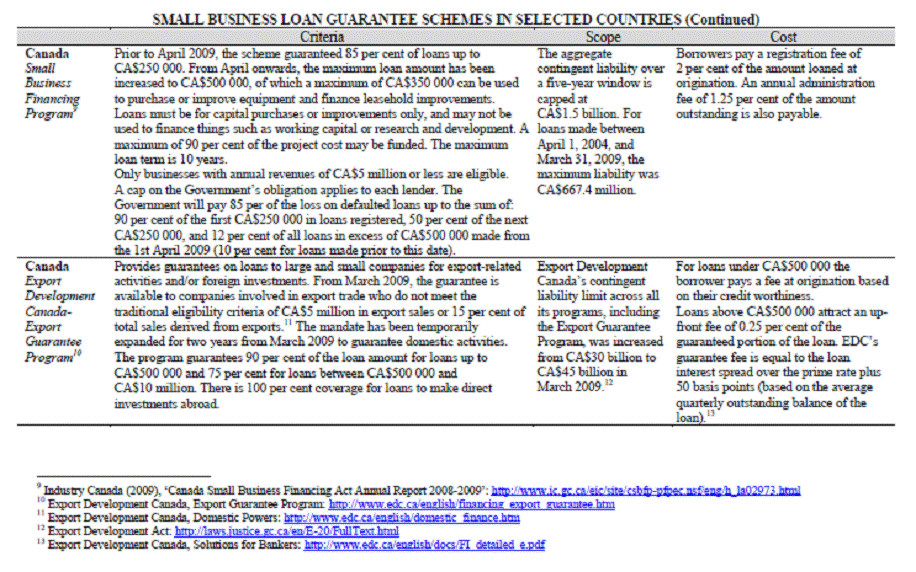


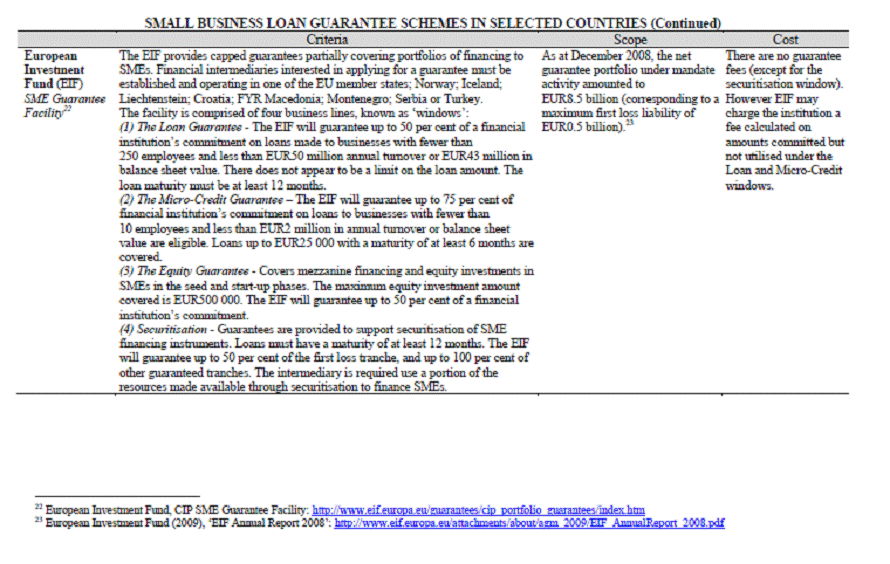
Navigation: Previous Page | Contents | Next Page